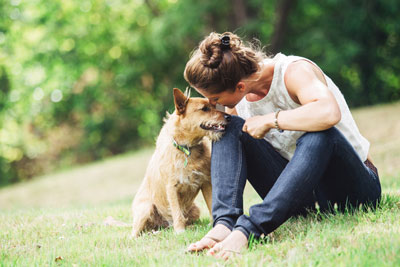First Aid for a Dog That Isn't Breathing

If you find your pet unresponsive, you will undoubtedly feel panicked. The first thing you will need to do is evaluate the situation and determine whether your pet is breathing.
How to Tell If Your Dog Is Breathing
First and foremost, you must be cautious while approaching a dog that is sick or injured. Even your own dog may react in uncharacteristic ways, potentially biting you, when she is in pain or scared.
Approach the dog slowly, keeping an eye on whether or not she reacts in any way. If she is unresponsive when you get next to her and place a hand gently on her shoulder, proceed in determining whether she is breathing.
- Place a hand on your dog's chest and feel for its rise and fall.
- Grab a tissue and hold it in front of your dog's nose. Notice whether or not it moves due to your dog's breath.
- Place your ear near your dog's nose (only if you're certain that she is unresponsive) and listen and feel for breathing.
A stethoscope is the easiest way to check for breathing and a heartbeat in your dog. You may wish to place a stethoscope in your dog first aid kit. Practicing ahead of time is the best way to get familiar with doing this.
If your dog isn't breathing, you will need to check for a heartbeat:
- Place your hand firmly on your dog's chest, where the elbow meets the chest wall when you flex her elbow.
- You may be able to feel a pulse by placing your fingers in your dog's groin, and feeling gently where the top of the leg meets the body wall.
Practice finding a pulse and respirations on your dog when there is no emergency.
What to Do If Your Dog Is Not Breathing
If your dog is not breathing and does not have a heartbeat, you will need to perform CPR.
If your dog is not breathing but does have a heartbeat, you should perform rescue breathing. A dog without respirations will suffer cardiac arrest soon, so you should act quickly and keep rechecking for a heartbeat periodically. Switch to CPR if your dog's heart stops.
Instructions for rescue breathing:
- Place your dog on her side.
- Tilt your dog's head back slightly to extend the neck out and open the airway.
- Pull your dog's tongue out forward between her front teeth.
- Look in your dog's mouth and remove any foreign object or material you see. Do not do this if your dog is conscious and responsive; you may be bitten.
- Place your mouth over your dog's nose. If your dog is large, you will need to place your hands around your dog's muzzle and your mouth, to make a seal, so air doesn't escape.
- Exhale into your dog's nose 4 or 5 times rapidly or once for 3-4 seconds. You should see your dog's chest rise. You will need to do this more gently for a small dog and more forcefully for a large dog.
- Check for breathing and a heartbeat.
- Continue rescue breathing until your dog breathes or for 20 minutes, after which your dog is not likely to respond to resuscitation attempts.
- If there is another person available to drive, head to a veterinary clinic while performing rescue breathing. Someone should call ahead if possible, so the staff will be ready to jump into action when you get there.
- If your dog's pulse stops at any time, switch to CPR.
You May Also Like These Articles:
Bloat in Dogs: Gastric Dilatation and Volvulus (GDV)
How to Be Prepared for Your Dog's Veterinary Bills
Disclaimer: This website is not intended to replace professional consultation, diagnosis, or treatment by a licensed veterinarian. If you require any veterinary related advice, contact your veterinarian promptly. Information at DogHealth.com is exclusively of a general reference nature. Do not disregard veterinary advice or delay treatment as a result of accessing information at this site. Just Answer is an external service not affiliated with DogHealth.com.
Notice: Ask-a-Vet is an affiliated service for those who wish to speak with a veterinary professional about their pet's specific condition. Initially, a bot will ask questions to determine the general nature of your concern. Then, you will be transferred to a human. There is a charge for the service if you choose to connect to a veterinarian. Ask-a-Vet is not manned by the staff or owners of DogHealth.com, and the advice given should not delay or replace a visit to your veterinarian.



